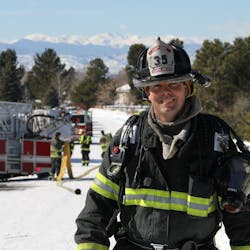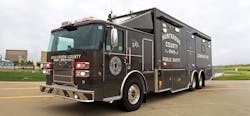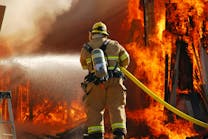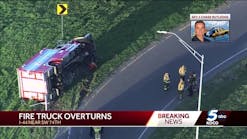Heart disease used to be the number one cause of firefighter deaths, with the second-leading cause being apparatus/automotive accidents involving water tankers/tenders. No longer is this the case, as numerous studies have proven that firefighters are at greater risk of contracting occupational cancers as a result of their assigned duties. In fact, the International Association of Fire Fighters (IAFF) reports that 61 percent of firefighter deaths from Jan. 1, 2002, to Dec. 31, 2016, were caused by cancer; heart disease accounted for 18 percent of career line-of-duty deaths (LODDs) for the same period.
The National Institute for Occupational Health and Safety (NIOSH) reports that firefighters have a 9 percent higher risk of being diagnosed with cancer and a 14 percent higher risk of dying from cancer than the general U.S. population (firefightercancersupport.org/resources/faqs). Fortunately, many agencies are committed to the overall health of employees, which includes recognizing the increased risk of cancer associated with firefighting activities. In an effort to provide a safe and healthy work environment, agencies are creating dynamic guidelines to reduce the cancer risk to its employees.
Further, many studies have shown that proper use of PPE and SCBA will minimize exposure to hazards that cause serious workplace illnesses. These illnesses may result from exposure to dangerous atmospheres, including chemical, radiological, physical, electrical, mechanical, or other workplace hazards. In addition, a complete decontamination process after training or clean-up on scene is proving to be beneficial in limiting the duration of firefighter exposure to toxic carcinogens left on the PPE and the personnel themselves.
But what about apparatus-specific guidelines or changes? What can departments, personnel and manufacturers do to reduce the risk?
Inside the station
Apparatus vehicle exhaust, mainly diesel exhaust, is a carcinogen that could affect firefighter health, and efforts should be made to minimize exposure at all times. For years, we dealt with black walls, black gear, and dayrooms/bunk rooms that smelled like diesel exhaust. That was when the only exhaust removal system was to open the bay door(s). I remember washing the walls at the station to remove all the black soot when the old Detroit Diesel 6V and 8V92s were the predominant engines in fire apparatus. These engines were the “Rock Stars” that were almost bulletproof, but smoked and leaked oil like crazy.
This is where the engine manufacturers have really stepped up, as required by the U.S. Environmental Protection Agency (EPA) starting Jan. 1, 2010, to reduce the amount of diesel engine particulate matter. The current EPA emissions standards are some of the most stringent in the world, reducing diesel particulate matter and nitrogen oxides (NOx) to almost zero levels on all diesel engines.
Here’s how it works, per the Diesel Technology Forum (dieselforum.org): The Selective Catalytic Reduction (SCR) system uses diesel exhaust fluid (DEF) injected into the exhaust stream of the engine, which sets off a chemical reaction that makes the engine “REGEN” to convert NOx into nitrogen, water and tiny amounts of carbon dioxide (CO2), which are the natural elements of the air we are breathing.
Are these SCR systems more costly? Yes, but according to the Diesel Technology Forum, most fleets and truck operators have reported a 3–5 percent gain in fuel economy for agencies that do track their fuel costs on fire apparatus with diesel engines.
In addition, several manufacturers make great station exhaust extraction systems that are automatically programmed and started when the battery or ignition switch is turned on by any unit at the station or when the unit arrives back to the station from a call. Further, there are vehicle-mounted diesel filters that can be used instead of a station exhaust removal system. The nice part about the vehicle-mounted diesel filter is that it can be included in your apparatus specification or retrofitted to your existing trucks without making expensive station modifications. Also, it can also be used on scene in areas that need to be cordoned off but where people are still operating.
My former department created the South Metro Fire Cancer Prevention Initiative Standard Operating Procedure (SOP), which outlines several steps that should be followed to help prevent motor vehicle exhaust from exposing all PPE within the bays of the stations:
1. All crews and personnel should utilize the exhaust systems and never let any apparatus/equipment run within the bays unless absolutely necessary. In the unlikely event that need arises to run apparatus in the bay, the exhaust system hose shall be in place at all times and the apparatus shall not exceed idle speed. In the event that an exhaust system hose is unavailable, the operator of the apparatus shall move the apparatus to the exterior as quickly as possible. All bay doors shall be closed to prevent further exposure. Standard backing procedures shall be used when moving apparatus. It should be the intent of crews and companies to work together to attach the exhaust hose as the apparatus enters the bays and also ensure proper connection prior to exiting.
2. Crewmembers should not conduct compartment/tool inspections while the apparatus is running. Crewmembers should wait until the operator has finished the apparatus run up/inspection and shut down the engine prior to these activities.
3. All PPE on storage racks that have the potential to be exposed to exhaust contaminants should be protected by closing and zipping bunker coats and pants so as to prevent particulates from landing on and absorbing into the liners. No bunker gear liners should be exposed when storing for off-duty.
4. No exhaust from any vehicle should expose bunker pants that are stored on the bay floor, most specifically the groin area of bunker pants and hoods typically placed on top of pants for call readiness. When possible, store gear within the apparatus to prevent contamination by exhaust.
5. Bunker gear shall not be worn in the living area of the station. Every effort should be made to limit the exposure of contaminants to the living area of the station. Crewmembers shall not wear duty boots/shoes into the living area of the station. Crewmembers are encouraged to have clean footwear available in the bay to wear in the interior of the station or clean their footwear prior to entering the living area after each response. Station captains shall provide supplies for decontamination at each station.
Outside the station
Fires produce carcinogenic smoke, and efforts should be made to minimize firefighter exposure from the PPE that was involved in any toxic type of environment. As such, the South Metro Fire Cancer Prevention Initiative SOP also addresses “outside the station” activities, defined as the conclusion of an incident involving products of combustion, including training fires.
Crewmembers must follow the policy following all structure, outbuilding, vehicle and dumpster fires; however, the incident commander (IC) may require personnel to follow this policy on any incident they deem necessary. The IC may exempt personnel who were not in close proximity and/or exposed to contaminants.
Following are the steps to assist in preventing exposure to contaminated PPE:
1. During incidents that involve exterior exposure to products of combustion and or running apparatus in close proximity of each other, air monitoring should be considered for the protection of crewmembers in that area. It is preferable to use a gas meter with a carcinogen ethylene oxide (EtO) sensor.
2. It is encouraged that apparatus that can be shut down, should be shut down during any incident to further limit crewmembers’ exposure to contaminants. Safety shall never be leveraged to meet this objective.
3. Upon the completion of suppressing fire and after exiting a fire event, a decontamination station (hoseline and decon bucket) should be setup to wash particulate from PPE. This includes bunker pants, jackets, helmets, structure boots (including soles), structure gloves, and SCBA. Personnel shall wear eye protection, medical gloves and N95 masks during decon procedures.
4. Hoods should be removed from around the neck area as soon as possible. District issued stocking caps should be worn for warmth in inclement weather in lieu of fire hoods.
5. Since PPE will continue to off-gas after exposure to heated environments, gear (including entire firefighter ensemble and SCBA) should be removed, bagged and placed in a back compartment or hosebed of the engine for transport back to the fire station to prevent further inhalation of toxic off-gas within apparatus cabs. Personnel shall don their wildland gear if necessary in the event they have a significant medical or other call while returning to the station. This will require all personnel to keep their wildland gear and boots on their apparatus at all times.
6. Decontamination wipes have been provided and shall be utilized to clean any areas of skin that are considered to be higher body absorption sites and/or areas not covered by bunker gear. These areas could include face, neck, ears, legs, groin, wrists and hands.
7. Plastic seat covers have been provided for all apparatus and shall be placed over all seats for the return trip to the fire station to prevent any contamination to the apparatus cab seats.
8. After return to the station, all frontline PPE used on scene shall be laundered as soon as possible according to district policy. Bunker boots, helmets including shroud, SCBA and bottles shall be washed with a brush and light soap before being placed back onto the apparatus. All firefighters will move into their backup set of gear until their frontline gear has been laundered.
9. As immediate as possible, and at company officer’s discretion, all crewmembers shall shower and change clothes upon returning to the station. Personnel should keep contaminated clothing separate from other clothing and wash at the station if possible.
10. Reasonable effort should be made to prevent continued contamination while transporting contaminated gear in personally owned vehicles.
11. The IC or their designee shall complete an exposure report whenever an incident occurs with crewmembers exposed to products of combustion.
Manufacturer responsibility
So what are the apparatus manufacturers doing to reduce the risk of cancer in the cabs and around the vehicles themselves?
Sutphen Corporation released its Clean Cab Initiative, and the first truck manufactured with its version of the clean cab concept for West Palm Beach, FL, includes:
· Exterior slide-out compartments for PPE gear and SCBA storage
· Diamond-plate floor covering
· No SCBA storage in the cab
· Low seam material on seating
· All surfaces are smooth, non-porous and cleanable
· HEPA filtering for the HVAC system
· Aegis anti-microbial spray for seats and hard surfaces
Pierce Manufacturing provides a Carcinogen Awareness and Reduction to Exposure (CARE) program that’s now been integrated into the apparatus design and construction processes. Spartan Emergency Response launched its own initiative for solving these problems with enhancements to its original Advanced Protection System (APS). Both manufacturers include the following:
· Warm water decon shower head outlets
· Smooth and cleanable apparatus seats and interior surfaces
· Non-porous door panels, headliners, doghouse covers, and seats
· Vertical exhaust that keep the fumes and heat away from the hose, compartments and walkways around the apparatus
· High-level HVAC filtering
· Compartment storage for all PPE gear and SCBA equipment
All manufacturers have started their own clean cab concept, which is now being accepted by many agencies that are making big efforts to keep all the contaminated PPE gear and SCBA equipment in outside compartments away from the firefighters and completely out of the cab occupancy area.
Seat manufacturers are also showing big initiatives to reduce the amount of absorption and contaminates in the fabric and cushion. Two seating companies, H.O. Bostrom and Valor, have removable seat fabric that can be easily removed and washed in an extractor, dried and placed back on the seat. Based on application and call volume, you can choose various options that include DURAWEAR material that is backed with a PVC liner that prevents contaminants from getting in or out of the cover or the cushion or the AEGIS antimicrobial protection. Both products create a cleaner environment for both fire and EMS personnel.
Final thoughts
For many departments, this is going to be a struggle with a very new concept. But believe it or not, many years ago, departments, mainly on the West Coast, started using this process and were able to put out fires when the PPE gear and SCBA were kept in the outside compartments. While it used to be a badge of honor to have dirty, smoky gear, we should have realized why other departments started this protective protocol. Nonetheless, too many agencies still have all of their PPE and SCBA in the cab. Many refuse to move the potential carcinogenic hazards out of the cab, as they claim it delays their response and on scene time in order to get out and don their gear. It’s inevitable that there will come a time when outside compartments will be mandated—so get ready.
References
Diesel Technology Forum. “What Is SCR?” dieselforum.org/about-clean-diesel/what-is-scr.
Firefighter Cancer Support Network (FCSN). “Preventing Cancer in the Fire Service FAQs.” firefightercancersupport.org/resources/faqs.
Healthline. “Why Cancer Is the Number One Killer of Firefighters.” healthline.com/health-news/cancer-is-number-one-killer-of-firefighters#6.
In the Fight: South Metro Assistant Chief of Operations Troy Jackson
“Do Everything Possible to Reduce Exposures to Carcinogens” — Troy Jackson
Troy Jackson has served with South Metro Fire Rescue in Colorado in the roles of captain, training chief and, currently, assistant chief of operations. In 2013, he was diagnosed with adenoid cystic carcinoma, a rare and non-treatable form of cancer. The diagnosis brought the department’s cancer initiative to the forefront, with an increased focus on everything from decontaminating gear to preventing exhaust in the stations to being more physically aware of one’s surroundings.
What has been your cancer journey thus far, from diagnosis to treatment?
In 2013, after years of treatment for asthma-type symptoms, my breathing was getting worse and was affecting both my job and personal life. Some imaging revealed a very large tumor in my trachea. In May 2013,
I had three inches of my trachea and the tumor removed. This was followed by both radiation and chemo.
I was diagnosed with adenoid cystic carcinoma. Since then I have had two more major surgeries to remove tumors and a second round of radiation treatments, over 70 in total. I am now in my third trial trying to find something that can put a dent in this disease.
After my first surgery, I spent a year offline trying to get strong enough to return on line. I made it back as a line captain and was promoted to training chief prior to my cancer returning. Today I am the operations chief and happy to be in a position where I can be productive and add value to the organization.
How has cancer impacted your life, on and off the job?
It has made me focus on the things most important to me, family and faith primarily. It gave me a killer new voice, as all the radiation damaged my vocal cords. It also made me step out of my comfort zone on the line and move up in the organization.
How did your brother and sister firefighters support you?
In more ways than I can articulate. Yard work, phone calls, rides to treatment, financially. Just knowing they were there if I needed anything at all.
What have you learned thus far through your battle with cancer?
Patience. That this disease has a profound impact on those fighting the battle and those supporting us during this time.
After learning that you had cancer, did you think back to any of your time on the fireground and question your actions?
Absolutely. Lots of stupid things as I look back. Bunkers next to the bed. No ventilation systems or exhaust capture systems in the bays. Only one set of gear. Never cleaning hoods. Culture of dirty gear and eating smoke makes you strong. Washing diesel soot of the bay walls without protective equipment.
Is there anything else that you would like firefighters to know about facing—and beating—cancer?
This is a wonderful and fulfilling career, but it does have its risks. Do everything possible to reduce exposures to carcinogens. Keep your body in tip-top shape to help fight the dangers our job has on our bodies.
Jackson and his doctors believe that his cancer is from firefighting because it is so rare and started in his airway. The doctors have told him that he will die from this cancer. Nonetheless, Jackson is a true champion at South Metro, as he is still fighting the good fight with a great attitude. There are at least 15 additional members in the department who have some form of cancer.
More from the Cancer Awareness & Prevention supplement:
- Clean Gear Matters
- Skellefteå Model Develops Healthy Firefighters
- Cancer Prevention Methods: Fact vs. Fiction
Download the full Cancer Awareness & Prevention supplement here.
Brian Brown
Brian Brown, a consultant with Craven and Associates, is the retired bureau chief, fleet services for South Metro Fire Rescue in Colorado, with more than 30 years fire/apparatus experience. Brown is a member of the Firehouse editorial board.








